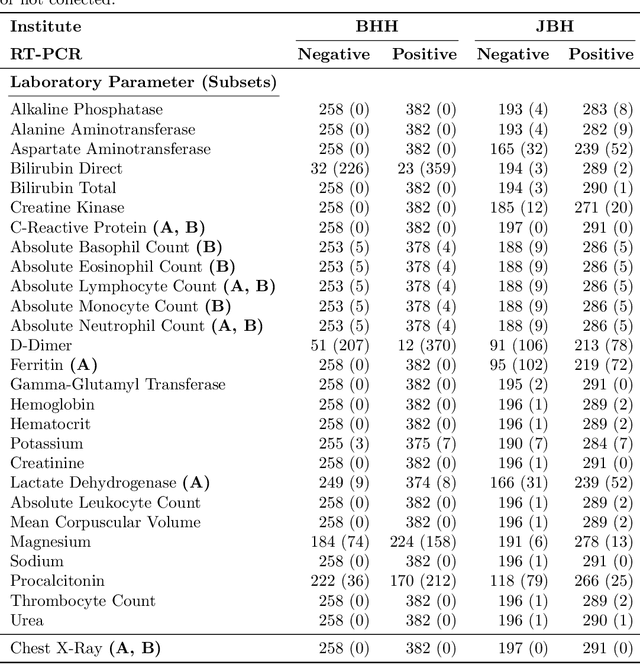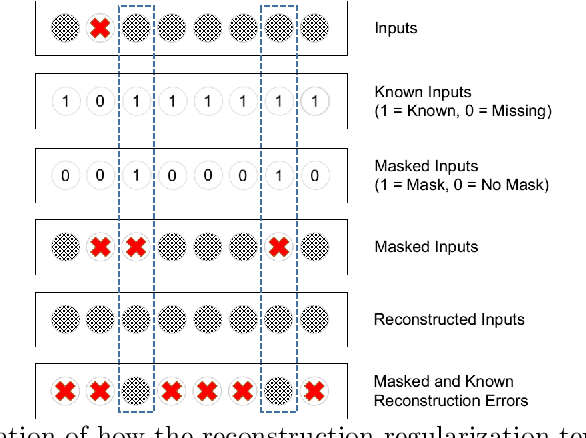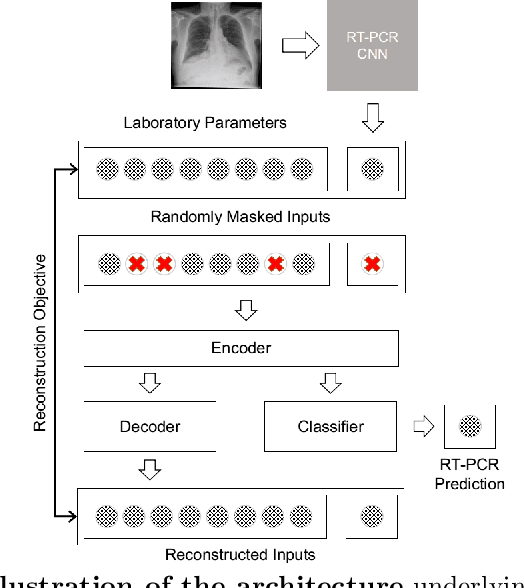Erdi Çallı
Deep Learning with robustness to missing data: A novel approach to the detection of COVID-19
Mar 25, 2021



Abstract:In the context of the current global pandemic and the limitations of the RT-PCR test, we propose a novel deep learning architecture, DFCN, (Denoising Fully Connected Network) for the detection of COVID-19 using laboratory tests and chest x-rays. Since medical facilities around the world differ enormously in what laboratory tests or chest imaging may be available, DFCN is designed to be robust to missing input data. An ablation study extensively evaluates the performance benefits of the DFCN architecture as well as its robustness to missing inputs. Data from 1088 patients with confirmed RT-PCR results are obtained from two independent medical facilities. The data collected includes results from 27 laboratory tests and a chest x-ray scored by a deep learning network. Training and test datasets are defined based on the source medical facility. Data is made publicly available. The performance of DFCN in predicting the RT-PCR result is compared with 3 related architectures as well as a Random Forest baseline. All models are trained with varying levels of masked input data to encourage robustness to missing inputs. Missing data is simulated at test time by masking inputs randomly. Using area under the receiver operating curve (AUC) as a metric, DFCN outperforms all other models with statistical significance using random subsets of input data with 2-27 available inputs. When all 28 inputs are available DFCN obtains an AUC of 0.924, higher than achieved by any other model. Furthermore, with clinically meaningful subsets of parameters consisting of just 6 and 7 inputs respectively, DFCN also achieves higher AUCs than any other model, with values of 0.909 and 0.919.
Deep Learning for Chest X-ray Analysis: A Survey
Mar 15, 2021



Abstract:Recent advances in deep learning have led to a promising performance in many medical image analysis tasks. As the most commonly performed radiological exam, chest radiographs are a particularly important modality for which a variety of applications have been researched. The release of multiple, large, publicly available chest X-ray datasets in recent years has encouraged research interest and boosted the number of publications. In this paper, we review all studies using deep learning on chest radiographs, categorizing works by task: image-level prediction (classification and regression), segmentation, localization, image generation and domain adaptation. Commercially available applications are detailed, and a comprehensive discussion of the current state of the art and potential future directions are provided.
FRODO: Free rejection of out-of-distribution samples: application to chest x-ray analysis
Jul 02, 2019
Abstract:In this work, we propose a method to reject out-of-distribution samples which can be adapted to any network architecture and requires no additional training data. Publicly available chest x-ray data (38,353 images) is used to train a standard ResNet-50 model to detect emphysema. Feature activations of intermediate layers are used as descriptors defining the training data distribution. A novel metric, FRODO, is measured by using the Mahalanobis distance of a new test sample to the training data distribution. The method is tested using a held-out test dataset of 21,176 chest x-rays (in-distribution) and a set of 14,821 out-of-distribution x-ray images of incorrect orientation or anatomy. In classifying test samples as in or out-of distribution, our method achieves an AUC score of 0.99.
 Add to Chrome
Add to Chrome Add to Firefox
Add to Firefox Add to Edge
Add to Edge